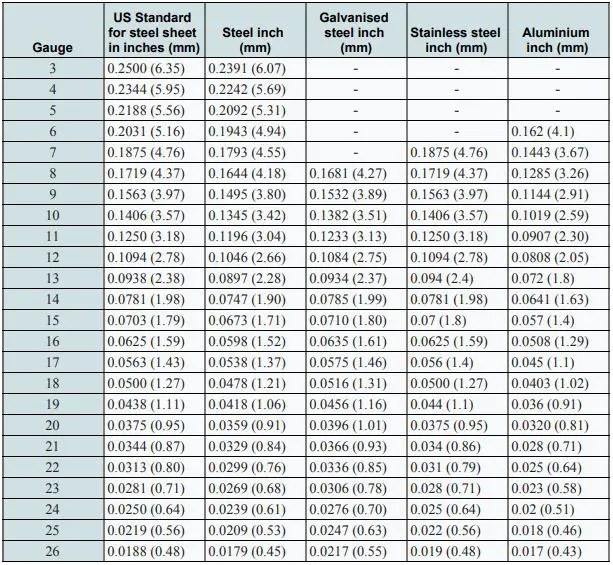Standard Steel Sheet Thickness
Standard Steel Sheet Thickness - Web the table below provides sheet steel weights and thicknesses in both us and metric according to the manufacturers’ standard gauge for sheet steel (msg), which is the primary commercial gauge system used by sheet. 16 gauge = 1.29 mm. Understanding these nuanced differences is vital when consulting a metal gauge chart to ensure that you're selecting the appropriate material for your endeavor. Anything thicker 6 millimetres is classified as metal plate, and anything. Web the chart below can be used to determine the equivalent sheet thickness, in inches or millimeters, for a gauge number from the selected gauge size standard. Web our selection includes premium copper and brass sheets, which can be sourced in dimensions up to 3000mm x 1000mm and 8ft x 4ft, with thicknesses reaching up to 3mm.
Web below is our best attempt to capture all of the standard gauge thickness of different materials. Web get a quote. The same and no other shall be used in determining duties and taxes levied by the united states of america on sheet and plate iron and steel. Originating from the browne & sharpe system in north america, gauge is a standardized unit used to specify the thickness of metal sheets, plates, and wire. Web a sheet metal gauge chart serves as a valuable tool for understanding the thickness of sheet metal materials.
Web carbon steel, galvanized steel and stainless steel use the manufacturer’s standard gauge scale. We also provide zinc sheets in sizes up to 3000mm x 1100mm and the standard metric 8ft x 4ft, with a maximum thickness of 1.5mm. 16 gauge = 1.29 mm. 0.025, 0.032, 0.040, 0.050, 0.063, 0.080, 1/8 (0.125) and 1/4 (0.25). Cold and hot rolled steel: As gauge numbers increase, material thickness decreases.
You’ll find the gauge and its corresponding thickness in inches and millimeters. In australia, the typical thickness of sheet metal is between 0.5 millimetres and 6 millimetres. What is the thickest and thinnest gauge of sheet metal?
Web Get A Quote.
This blog will help you out! 0.025, 0.032, 0.040, 0.050, 0.063, 0.080, 1/8 (0.125) and 1/4 (0.25). Originating from the browne & sharpe system in north america, gauge is a standardized unit used to specify the thickness of metal sheets, plates, and wire. We also provide zinc sheets in sizes up to 3000mm x 1100mm and the standard metric 8ft x 4ft, with a maximum thickness of 1.5mm.
As Gauge Numbers Increase, Material Thickness Decreases.
Below you will find a chart for metal thicknesses and weights. By providing a standardized measurement system, it allows users to quickly determine the thickness based on gauge numbers. Web what is the standard thickness of sheet metal? 16 gauge = 1.588 mm.
Anything Thicker 6 Millimetres Is Classified As Metal Plate, And Anything.
Gauges indicate the material thickness of specific sheets. Web sheet metal gauge is a fundamental measurement in metalworking that denotes the thickness of sheet metal. Web a chart of sheet metal thicknesses converted to gauge and inches. Gauge are used to specify the thickness of a metal sheet.
Commonly Used Metals For Manufacturing At Our Shop Are:
Web the term gauge steel is often used to refer to the thickness of sheet metal made of steel. Covers aluminum, stainless steel, galvanized steel, and sheet steel. Web a gauge conversion chart can be used to determine the actual thickness of sheet metal in inches or millimeters. Dive in to explore how gauge numbers vary by material and streamline your production process.




